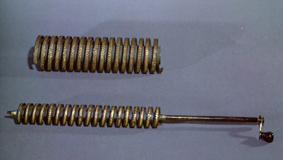
68.5 x 5 (diameter) 38 x 10 (diameter)
Gold painted tin, iron, brass and wood
CAT. 1824 : C.II.21
Outro parafuzo de Archimedes de lata, que está metido dentro de outro também de lata, aos quaes se pode dar differente inclinação, e mostrão que a subida dos corpos pode ser feita ou simultaneamente por ambos, ou somente por um delles, conforme quizer o observador.
Another Archimedes' screw of tin, which is mounted inside the other, both of them allowing different inclinations, showing that the raising of bodies can be made simultaneously by both, or only by one of them, as the observer wishes.
The famous Archimedes' screws were designed to raise the water contained in a receptacle. The example shown here was used for teaching. The screw was mounted on a support so that it remained inclined relative to the surface of the water and with its lower end immersed. When it was made to turn around on its axis, through the action of a crank, the water was obliged to rise up the screw.
This model comprises two independent pieces. One of them is a hollow tube into which the other can be introduced. With the tubes mounted in this way, the quantity of water raised by each turn of the screw was more than if just one piece were utilized.
Sigaud de la Fond, Joseph-Aignan, Description et usage d'un Cabinet de Physique Expérimentale, Paris, 1775, Vol. I, Pl. XVI,
Figs. 4 and 5.